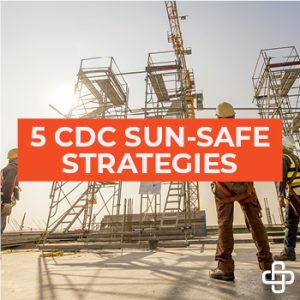 Did you know that every year, Americans lose more than $100 million in productivity because of restricted activity or absence from work due to skin cancer?
Did you know that every year, Americans lose more than $100 million in productivity because of restricted activity or absence from work due to skin cancer?
Skin cancer can be serious, expensive, and sometimes even deadly. Skin cancer cases continue to increase in the United States. Fortunately, most skin cancers can be prevented.
As The U.S. Department of Health and Human Services has named July as Ultraviolet (UV) Safety Month, we wanted to share CDC sun-safe strategies for protecting sun-exposed employees.
5 Ways to Increase Sun Protection for Employees
1. Encourage sun safety among your employees and provide sun protection when possible.
This includes wearing:
- Protective clothing
- Sunglasses
- Hats that shade the face, ears, and back of the neck
- Using a broad-spectrum sunscreen with an SPF of 15 or higher.
2. Schedule breaks in the shade and allow workers to reapply sunscreen throughout their shifts.
3. Modify the work site by:
- Increasing the amount of shade available—for example, with tents, shelters, and cooling stations.
- Decreasing UV reflection by covering bright or shiny surfaces.
4. Create work schedules that minimize sun exposure.
For example, schedule outdoor tasks like mowing for the early morning instead of noon, and rotate workers to reduce their UV exposure.
Remember…UV rays are strongest:
- During midday.
- Near the equator
- During summer months
- At high altitudes.
Employers can train workers to use the UV Index and adjust scheduled work when UV levels are “very high” or “extreme.”
5. Add sun safety to workplace policies and training
- Include sun-safety information in workplace wellness programs. For example, programs designed to help employees avoid heat illness can be adapted to include information about sun safety.
- Teach outdoor workers about risks of exposure to UV radiation and the signs and symptoms of overexposure.










